Heavy experimental tank T-100
By the 1938, the five-towed heavy tank T-35, which had not taken part in the hostilities before that time, was already obsolete. The means of defense that appeared by that time cast doubt on the possibility of his successful confrontation with tools of caliber 37-47 mm. Attempts to enhance the protection of T-35 by shielding and applying invoice armor led to an increase in the combat mass and reduced mobility of the vehicle and did not provide the desired effect. In this regard, the Main Military Council, held in April 1938, which addressed the issue of the Red Army’s weapons system, decided to create a new heavy tank with powerful armor and weaponry - a heavy breakthrough tank capable of operating in the most difficult fortified areas.
At the same time, the tactical and technical requirements (TTT) to tank of such a type. Work on the creation of new heavy machines was deployed in the design bureaus of three factories: the Leningrad Kirovsky, the Leningrad Experimental named after S.M. Kirov (No. 185) and the Kharkov steam locomotive named after the Comintern (No. 183).
A new type of heavy tank was developed on the basis of the layout of the heavy tank T-35 in order to enhance its armor protection, firepower and mobility. During the development of this scheme, the designers considered various options for installing weapons in five and three towers. The final decision was made in favor of the three-tower design.
In October, 1938, for review by the state mockup commission, teams of design bureaus of the Leningrad Kirov and Experimental Plants presented drawings and models of new heavy tanks, designed for each TTT. Kirovsky Zavod presented a heavy breakthrough tank for the QMS - Sergey Mironovich Kirov, and the Experimental Plant presented a heavy breakthrough tank for the 100 Product, later called T-100.
Work on the creation of a heavy tank breakthrough T-100 was started in the summer of 1938 in the design office of Experimental Plant No. 185 under the guidance of S.A. Ginzburg. The main design work on the new machine was performed by I.S. Bushnev G.V. Kruchenykh, G.N. Moskvinym, E.Sh. Paleem and L.S. Troyanov. E.Sh.Paley was appointed the lead tank engineer. Initially, according to TTT, the option of installing weapons in three turrets was developed: the 76,2-mm tank gun L-10 in the main turret and two 45-mm tank guns arr. 1934 in two small towers. However, after considering the design and layout of the tank, so that with the thickness of the armor 60 mm the mass of the machine did not exceed 55-57 t, one small tower was refused and further work was carried out on the double-turret option.
The main work on the manufacture of components, assemblies and tank assembly was performed by plant number XXUMX, armor by the Izhora plant, and transmission units by plant number XXUMX in Kharkov. A test drive of the car to the courtyard of the pilot plant without installed towers with weapons, a driver's hatch, viewing instruments, internal and external communications and ammunition elements took place on 185 on July 183. The subassembly of the tank was detained at the plant - plant N 2, which all its production capacity threw on the manufacture of a prototype tank A-1939.
The final assembly of the machine was completed by 31 on July 1939, and the T-100 was adopted by the panel for field testing, which was combined with the factory tests.
1 August 1939 T-100 entered the landfill tests, which, according to the test program approved by the Red Army’s Avtronetank Management (AVTU) of the Red Army, were to end on January 3 1940. However, it was not possible to carry out this work in full In the middle of November, the 1939 machine was removed from the tests and was subsequently sent to the Karelian Isthmus for "special tests", which meant checking its combat and road performance in front-line conditions as part of a specially formed group of experienced tan kov, manufactured by the factories of Leningrad.
The layout of the tank differed from the classic placement of weapons in two conical towers, located one after the other along the longitudinal axis of the hull. The rear main tower of circular rotation was mounted on a tall box of turrets. In the forward part, in the control compartment, a mechanic-driver was located along the axis of the machine, to his right was a radio operator. The fighting compartment was located in the middle part of the corps and included the fighting compartments of the two towers.
General view of the tank T-100
In the fighting compartment of a small turret there was a gunner (commander of the turret) and a loader, in the battle compartment of a large turret - a tank commander, a gunner and a loader. In addition, there was a place for a technician.
The main weapon used was the X-NUMX-mm L-76,2 gun (L-11), installed in the main turret with vertical guidance angles from minus 10 to plus 5,5 °, and in the small tower 26-mm tank gun obr. 45 with a horizontal angle of 1934 ° and vertical guidance angles from minus 256 to plus 4,5 °. Mechanisms of rotation of the towers had electromechanical and manual drives. As an additional weapon, the tank had two DT machine guns paired with guns, and one DT anti-aircraft machine gun with vertical guidance angles from minus 26 to plus 12 °, mounted in a turret of circular rotation located on the roof of the main tower above the tank commander’s seat. To rotate the turrets, a special mechanism was used, in the handwheel of which a hand drive was installed the electric trigger button of a machine gun. The tank ammunition consisted of 77 shots for 120-mm guns, 76,2 shots for 393-mm guns placed in special metal cassettes of three shots and 45 cartridges packed in 4284 machine guns for DT machine guns.
The L-11 tank gun manufactured by the Kirov Plant, which was installed later, differed from the L-10 in the length of the rifled part (23,5 gauges instead of 17 in L-10), and therefore, more than the initial velocity of the armor-piercing projectile (612 m / s instead of 555 m / s) and greater armor penetration (63 mm at a distance of 1500 m at an encounter angle of 90 °). V-bolt with percussion mechanism with self-coil was replaced by a bolt-type gun mod. 1927 d. The mechanism for switching off semi-automatics was added and the lifting mechanism and the mechanisms for manual and foot descents were changed. Direct firing range was 3600 m, and the greatest - 12 000 m. Practical rate of fire was 6 - 7 shots per minute.
Panoramic and telescopic sights were used for aiming firing and observation of the battlefield by the crew: for the 45-mm gun - PTKU and TOP, for the 76,2-mm gun - PTK, PT-1 and TOD, for the anti-aircraft machine gun - TPP. In addition, in the towers and car body there were mirror viewing devices and slots with triplex glass.
The armor protection of the hull and the two towers was counter-axial, of equal strength, made of armor parts with a thickness of 60 mm with rational angle of inclination, interconnected by a combined method of tugs, followed by welding of the seams. For landing and exit of the crew there were hatches - one in each tower and in the forward part of the hull on the right along the car. In addition, an emergency hatch was made at the bottom of the tank. For ease of maintenance of the engine and transmission units in the field in the roof of the engine compartment and the stern of the tank there were special hatches, closed with armored covers.
In the rear of the hull, a carburetor was installed. aviation four-cycle twelve-cylinder V-shaped engine of liquid cooling GAM-34-VT (power 850 hp, 1850 rpm) and mechanical transmission. The engine was started using compressed air or an electric starter ST-70 with a capacity of 15 hp The cooling of the engine water radiators was carried out using an axial fan with helical blades mounted horizontally on the gearbox as a medium T-29 wheeled-tracked tank. Air for cooling the engine was sucked in by the fan through the side pockets of the air intake, covered with protective nets and located in front of the engine compartment. Exhausted hot air was ejected at the rear of the engine compartment onto the upper branches of the tracks. Aviation gasoline was used as fuel, which was located in four aluminum fuel tanks with a total capacity of 1160 liters. Such an amount of fuel provided the tank with a cruising range of 160 km along the highway and up to 120 km along the lane.
The transmission used a five-speed three-way gearbox, providing five speeds forward and one speed back, three-disk main friction dry friction (steel on ferrodo), multi-disk side friction dry friction (steel on steel) with band brakes lined with ferrodo and simple single-row side gearboxes . Onboard friction and brakes had pneumatic control servo-drivers and redundant mechanical drive. The pneumatic type servo-control of the machine with a closed cycle of operation consisted of a single-stage two-cylinder compressor with a capacity of 105 l / min (1200 rpm) driven by a gearbox, tracking system, pneumatic cylinders , radiator, high and low pressure air cylinders and pipelines. With the help of servo control, the car was turned and braked, which made it possible to reduce the force on the turn levers to the minimum - 10 kg, and on the main clutch pedals - to 15 kg; however, in case of failure of this system, the management of the tank was difficult due to the large efforts on the levers (up to 80 kg). During the test run, servo control of the main clutch pedal was removed due to poor drive performance.
In the undercarriage, an individual crank-balance suspension was used with leaf springs on seven support rollers on board and a buffer spring on the front roller. The suspension elements were protected from possible combat damage by the armor screen and support rollers. The caterpillar propeller included 18 duo-pivot support and 10 supporting rollers with external cushioning, drive wheels with removable toothed rims, guide wheels with screw tension mechanisms, and fine-grained hovering tracks made of forged tracks with an open metal hinge. The track chain was tensioned from the control room.
Electrical equipment of the machine was performed on a single-wire circuit. The voltage of the on-board network 12 and 24 V (starter circuit) was provided by four starter 6STE-144 batteries connected in series and a DC generator with a power 2,5 - 3 kW. The generator was installed on the gearbox and was driven by the gear drive of the engine cooling fan.
The 71-SO KAK-3 radio station with the UMN-750 and RUN-10 radio stations was installed on the tank as a communication device. In addition to the radio station, a color signal signaling device was installed for external communication in the machine-gun turret: white, red and green. Intercom system was used intercom TPU-6.
Fire-fighting equipment consisted of hand-held fire extinguishers with carbon tetrachloride.
The T-100 tank with a combat weight of 58 t developed a maximum speed of 35,7 km / h on the highway, along the country road to 10,3 km / h, and had good throughput indicators. The machine could go up steep slopes up to 42 °, ditches 4 m wide, upright wall 1,3 m high, ford up to 1,25 m deep and move along a slope with a roll angle up to 25 °.
At the end of 1939, a self-propelled unit, a T-100Z tank with more powerful weapons, and an engineering tank were developed on the basis of the T-100 tank. In March 1940 was made in the metal self-propelled unit SU-100Y, and for the T-100Z tank the main (rear) turret with the howitzer M-10 of the caliber 152,4-mm. The T-100Z tank was developed under the guidance of LS. Troyanova, lead engineer of the machine was E.Sh. Paley.
An engineering tank based on the T-100 was designed to perform tasks for building bridges, transporting people and bringing explosives in special boxes. In the subsequent it was supposed to be used as a base for the creation of self-propelled artillery installations. The prototype machine was not completed, and its manufactured chassis was used in the construction of self-propelled artillery SU-100Y.
Based on the analysis of military operations in the war with Finland and the use of new heavy tanks, in the spring of 1940, the design bureau of plant N 185 on the basis of the T-100 tank developed a project for a new heavy tank - “Product 103” (project lead engineer - Shufrin). The machine was designed to suppress ground firing points and combat fleet the enemy. A wooden model of this machine was made, but further work on it was deemed inappropriate and discontinued due to the fact that the T-100 tank was not accepted for service, as well as due to the lack of a base chassis.
Combat application
The crew of the T-100 consisted of military personnel of the 20 heavy tank brigade: commander Lieutenant M. Astakhov, artillerymen Artamonov, Kozlov, radio operator Smirnov and workers of the plant number 185 them. Kirov, driver A. Lyukhin, backup driver V. Drozhzhin and mechanic V. Kaplanov. QMS, T-100 and KB formed a company of heavy tanks under the command of captain Kolotushkin. 10 December 1939 of the company arrived at the front and was attached to the 90-th tank battalion of the 20-th heavy tank brigade.
The combat use of the QMS and the T-100 was described in some detail in the book "Designer of Combat Machines" (Lenizdat, 1988). That's what you can find there about this: the SMK tank was moving at the head of the tank column, and in this battle (meaning December 18) was under fire for a long time ... At the junction of Camaris? Vyborg driver did not notice a pile of boxes and, apparently, ran over them. There was a strong roar, brown smoke clouded all around. The tank stopped. After waiting for the smoke to disperse, Senior Lieutenant Petin emerged from the tank and examined the wrecked car. The QMS stood at the big funnel. The blast of a mine or a landmine planted here damaged a sloth and a caterpillar, blew off transmission bolts. Electrical equipment has failed. caved the bottom of the car body. It was an 40-degree frost, but the snow around the tank from the explosion almost completely melted ...
The double-stormed tank T-100 and KB approached and stood next to each other. The crew of the T-100 were volunteers-testers of the Leningrad plant of experimental engineering named after Kirov, and among them E. Roshchin. Remembering this fight, he said: going up to the damaged QMS, our cars covered him with their armor. The T-100 stood in front and to the right, and the KB also in front, but a little to the left, so a triangular armored fortress was formed from three cars. In such a construction, we not only lasted for several hours, but also tried to put the QMS on the course, connecting broken caterpillars ... But the damage was too great - except for the tracks
The front view suffered skating rinks, and the heavy machine could not be moved.
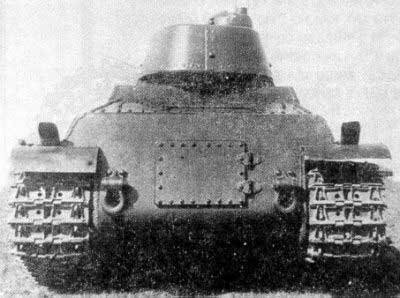
Front view

Rear view
The evacuation group of Lieutenant Toropov tried to pull out the damaged SMK tank using the X-NUMX-ton T-25 tank as a tractor. We worked at night under enemy fire, but we couldn’t pull out this huge monster, firmly entrenched in the funnel. The injured sloth and torn caterpillar completely deprived the tank of mobility. I had to leave it in the neutral zone.
Indeed, a company of heavy tanks participated in the attacks of the 90 tank battalion in the Summa-Hottinen area 17-18 in December 1939. During these battles, the tank KB was shot through the barrel of the gun, and the car was sent for repair. A blown QMS 19 December. On this day, the 90 Tank Battalion of the 20 Tank Brigade broke through the line of Finnish fortifications. Together with the battalion, the QMS and the T-100 escorted the line of fortifications, accompanied by five T-28 tanks. The details of this battle were found in a document sent by the Directorate of Plant No. 185 to the headquarters of the North-Western Front in February 1940. Below we provide this document in full, with the spelling preservation of that time:
On the presentation to the awarding of workers of the plant number 185 and military personnel from the crew of T-100.
At the outbreak of hostilities, the 100 tank was requested by the Red Army command in the active army. Voluntarily expressed a desire to join the ranks of the Red Army to service 100 in combat operations at the front:
- driver t.Plyukhin Afanasy Dmitrievich;
- spare driver t.Drozhzhin Vasily Agapovich;
- mechanic t.Kaplanov Vladimir Ivanovich.
These comrades, along with tank commander Lieutenant Astakhov, Mikhail Petrovich, gunners TT. Artamonov, Kozlov and radio operator T. Smirnov, were enlisted in the crew of the 100 and transferred to the company of the heavy tanks of the 90 tank tank battalion 20 and tank brigade During his stay at the front, the crew repeatedly participated in the battles. Particularly noteworthy is the participation of 100 in the December 19 combat operation of 1939 in the Summa Grove area.
In this operation, the White Finns were blown up and the QMS tank was disabled. Under artillery and machine-gun fire of white Finns (seven hits in 100 37-mm and 47-mm shells and numerous bullet hits) the driver T. Pluukhin, shutting down the defeated SMK with his car, after long attempts to get him out of battle by towing T-100, trying not crowned with success because of the slip of the T-100 tracks (the presence of ice) The crew of the undermined SMK destroyed the tank's units and its armament.
The crew of the T-100 developed hurricane fire from cannons and machine guns and thus made it possible for eight people of the QMS crew to go through the emergency hatches (at the bottom of the T-100 and the QMS) from the QMS to 100. At the same time, the driver of T.Plukhin did not stop observing the actions of the enemy and fired from a revolver at the white Finns trying to get close to the tank.
In this operation, the junior commander from the crew of the QMS tank, t.Mogilchenko, was seriously wounded. After an unsuccessful attempt to pick it up in the 100 through the emergency hatch in the bottom (the latter was jammed with machine-gun cartridges), vols. Drozhzhin and Kozlov, under the fire of the White Finns, emerged from the T-100 through the hatch of the small tower and, picking up the wounded man, dragged him into 100.
In this operation, the entire crew under the command of Lieutenant Astakhov led a continuous battle with the enemy for five hours. On the same day, the engine stalled in the 100 battle. The motorist T.Plukhin quickly eliminated the cause of the defect (cutting the thread of the magneto adjustment clutch), skillfully switched to working with one magneto (instead of two), started the engine and enabled the tank to continue to perform the task.
Plyukhin A.D. the birth of 1910 of the year, a member of the CPSU (b);
Kashtanov V.I. the birth of 1911 of the year, candidate member of the CPSU (b);
Drozhzhin V.A. Born 1907 of the Year, Candidate Member of the CPSU (B).
Reporting on the above, we present to awarding orders and medals to the workers of the plant Plyukhina AD, Kaplanova V.I., Drozhzhina V.A. and servicemen Lieutenant Astakhov, artillerymen Artamonov, Smirnov and radio operator Kozlov.
Plant Manager No.185 Barykov / signature /
Party Party Central Committee of the CPSU (b) of the plant №185 Fomin / signature /
Military representative of ABTU at the plant number 185 of the military Ner 2-rank Tsipko / signature /
10 February 1940 year.
The T-100 tank after the repair of the 18 engine in February 1940 was again sent to the army (it is possible that E. Roshchin was included in his crew at this particular time). The machine acted together with the KB tanks as part of the 20 (February 22 and March 1) and 1 March (11 - March 13) tank brigades. During this time, the car passed 155 km and received 14 hits with anti-tank cannon shells (port side - 6, mask 45-mm gun - 1, niche of the big tower - 3, left track - 3, left sloth - 1). In all cases, the armor was not pierced. After the war, the T-100 arrived at the factory, where the engine was replaced and the tank was easily repaired. Total for 1 April T-100 passed 1745 km, of which 315 km during the fighting on the Karelian Isthmus.
The base T-100 served to develop several combat vehicles created from the experience of fighting in Finland. From the very beginning of the Soviet-Finnish war, the Red Army sharply felt the need for special armored engineering vehicles. Therefore, in mid-December 1939, the Military Council of the North-Western Front ordered the plant No. 185 to design and manufacture an engineering tank of anti-rigging reservation based on T-100. This machine was designed to perform tasks on bridge guidance, transportation of sappers and explosives, and evacuation of damaged tanks. However, in the course of designing, the design bureau of the plant received from the head of the ABTU of the Red Army, D.Pavlov, the assignment task of setting the 152-mm gun or another suitable, with high initial speeds, to the T-100 base to combat the bunker. In this regard, the director of the plant №185 N. Barykov appealed to the Military Council of the North-Western Front with a request to cancel the decision on the manufacture of an engineering tank and make a decision on the installation on the 100 machine 130-mm naval gun. The request was satisfied, and already on January 8 1940, the drawings of the hull T-100-X (X) - such a designation was received by the machine, were transferred to the Izhora plant.
The T-100-X differed from the T-100 in place of a wedge-shaped chopping tower with the X-NUMX-mm B-130 naval gun. The suspension of the car was designed by the torsion bar, and its manufacture was entrusted to the Kirov plant, which had experience in this field. During the manufacture of armored parts to speed up the assembly of the machine, the shape of the cabin was changed to a simpler one. The new self-propelled unit received an index T-13-U (Y). The armored hull T-100-U arrived from the Izhora 100 plant in February, the 24 in March began assembling the machine, and the 1 in March finished the self-propelled gun made its first exit.
But the war was already over by that time, and T-100-U was unable to survive in a combat situation.
During the Soviet-Finnish war, an attempt was made to modernize the T-100 armament. In January, 1940, Deputy Commissar of Defense, 1 rank commander G. Kulik, instructed to reinforce the armament of the T-100 by installing an X-NUMX-mm howitzer M-152 on it to fight the dead teeth.
By mid-March, the 1940 was made a new tower with an X-NUMX-mm howitzer M-152. It was supposed to be installed in place of the X-NUMX-mm L-10 cannon on the T-100. The machine with the 7-mm artillery system received an index T-11-Z (z). But the new tower was never installed on the tank in connection with the adoption of the KB-152 and KV-100, the ABTU RKKA ceased all work to further improve the T-1.
It is interesting to quote excerpts from reports on field testing of SMK and T-100 tanks, prepared by a commission chaired by P. Voroshilov. Moreover, these reports are dated 22 February 1940 year: at this time, the QMS was on the battlefield, and T-100 again went to the front.
The report on the T-100 noted that the cooling system was not fully developed, the grids clogged with leaves as they move through the forest, and the fan is not reliable. It is necessary to modify the gearbox control mechanisms; the design of the side friction clutches should be revised in the direction of amplification. The presence of the pneumatic control system of the tank was noted as advantage. In conclusion, it was said that the T-100 with the specified TTX corresponds. It is inappropriate to recommend for adoption by the Red Army, since the KB tank was made and adopted.
However, representatives of the plant number XXUMX, director Barykov and chief engineer Gidkov, expressed a special opinion, which consisted of the following:
The statement of the commission that it is not advisable to recommend T-100 for adoption if there is a decision to adopt a KB is incorrect, since the double-turbo T-100 is a machine of a different class compared to the CV. The statement that the KB has the best performance characteristics is essentially not true: on the armament of the 45-mm and 7-mm or 45-mm and 152-mm in the T-100 and in the KB 7-mm or 152-mm, in patency, in power reserve.
Therefore, the plant considers it absolutely necessary recommendation of the adoption of the T-100 into service, even in the presence of HF. In addition, it is possible to install an 100-mm naval gun in T-130 in its dimensions, which cannot be done on KB. But no decision was made on this particular opinion.
The further fate of the last Soviet multi-turrets took shape differently. The QMS was delivered to the Kirov Plant. On the instructions of the ABTU Red Army during the 1940 year, the plant had to repair the tank and transfer it to the Kubinka landfill for storage. However, for unclear reasons, before the start of World War II, repairs were not made, and after the war, the QMS went to the smelter.
The T-100 tank in the summer of 1940 was transferred to Kubinka for storage, and after the start of World War II it was evacuated to Kazan and then to Chelyabinsk. Here the car was placed at the disposal of the experimental plant No. XXUMX, where it remained until the end of the war. The further fate of the car is not established, but according to some data, until the middle of the 100-s, it was located on the territory of the Chelyabinsk Tank School.
| Tactical and technical characteristics of the experimental tank T-100 | |
| Year of construction | 1939 |
| Crew | 8 |
| Mass, t | 58 |
| Dimensions: length, m width, m height, m | 8,495 3,4 3,43 |
| Clearance, m | 0,525 |
| Track width, m | 0,7 |
| Armor protection, mm | 60 shell forehead mm Body side 60 mm Feed 60 mm Roof 20 mm Bottom 20-30 mm |
| weaponry | 76,2-mm gun (L-10) L-11 45-mm gun obr. 1934-38 3 x 7,62-mm machine gun DT. |
| Ammunition | 200 shots 393 shots 4284 cartridges |
| Means of communication - external communication - intercom | 71-TK-3 TPU-6 |
| Engine | GAM-34-BT 12 cylinder, 850 hp |
| Fuel tank capacity, l | 1160 |
| Average specific ground pressure, kg / cm2 | 0,68 |
| Power reserve, km | on the highway - 160 on the ground - 120 |
| Max. speed km / h | 35,7 |
| Obstacle obstacles: rise, hail heel moat, m wall, m ford, m | 42 25 4 1,25 1,25 |
The self-propelled unit T-100-U was also transferred to Kubinka in the summer of 1940. Since the beginning of the war, the SAU has not evacuated anywhere. In November, the X-NUMX of the T-1941-U, together with the 100-mm experienced ACS SU-152 and SU-14-14, became part of the special-purpose self-propelled artillery division. However, information about the combat use of T-1-U could not be found.
The T-100-U has survived to the present day and is located in the Military History Museum of armored weapons and equipment in Kubinka, situated near Moscow.
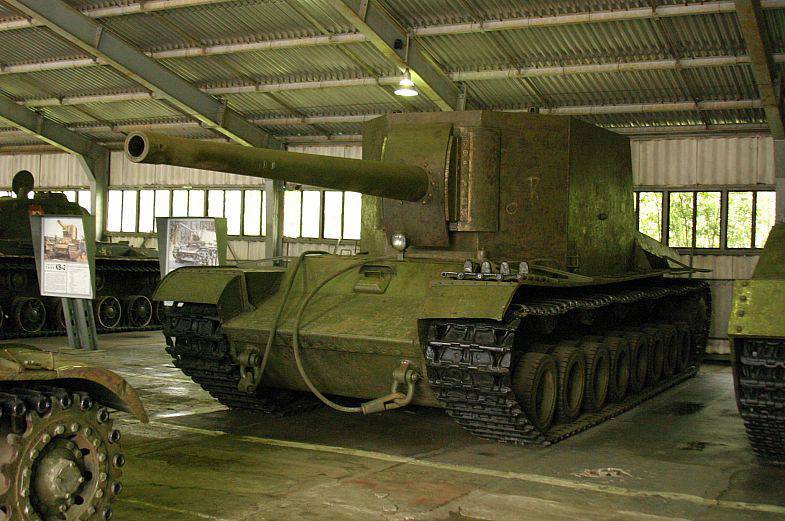
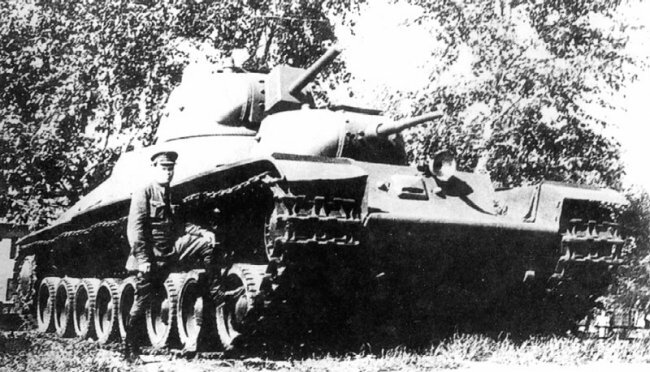
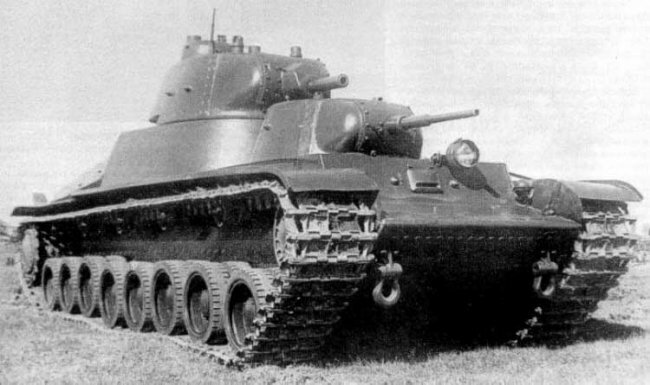
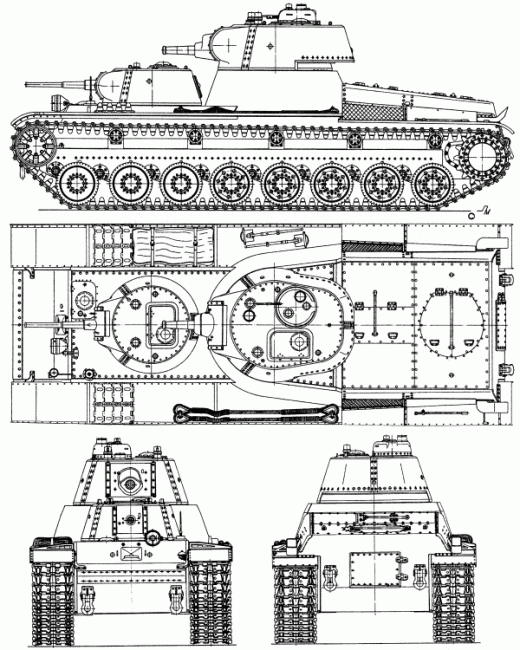
Information